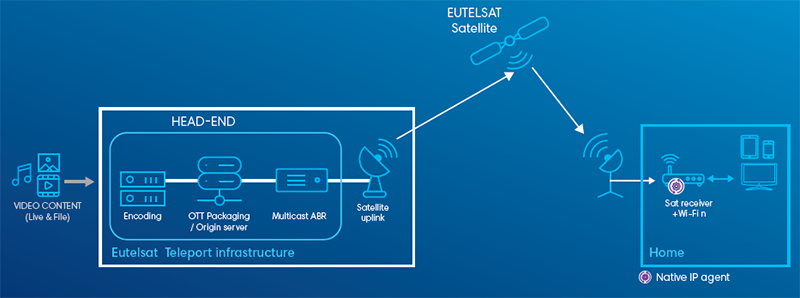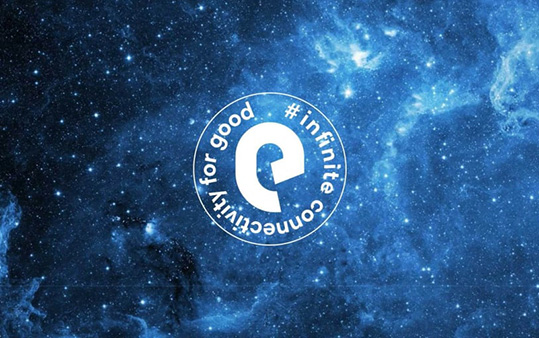- Service scalability at predictable costs: IP multicast capabilities address OTT/unicast delivery challenges for premium live events and can offer reduced cost of content delivery.
- Consistent user experience: End-users access the service on multiple devices, both at home and on-the-move with a unified and consistent user experience.
- Broader end-user reach: Bring-your-own-device model enhances accessibility.
- Greater sustainability: Multicast distribution reduces power consumption compared to terrestrial IP, lowering the carbon footprint of the service.
Revolutionizing TV broadcasting with Next-Gen. content delivery to homes
Offering a multi-screen, multi-room experience on any device, providing top-tier quality for live and offline video reception, personalized content, superior user interfaces, and comprehensive analytics - these are all part of the challenge broadcasters face when delivering content to their end-users.
Today, two new industry standards developed through a collaborative initiative of the broadcast community are enabling broadcasters to do just that: DVB-Native IP for next-generation broadcast delivery and DVB-I for unified and simplified content discovery and delivery of rich content guide metadata.
At IBC 2024, Eutelsat, in co-operation with Rai, Italy's public broadcasting company, and Inverto, a leading supplier of broadcast reception equipment and video streaming solutions, will be demonstrating how these new DVB-NIP and DVB-I industry standards can be combined to offer next-gen. Direct-to-Home (DTH) free-to-air TV services to provide a game-changing viewing experience on personal devices in addition to legacy TVs and connected TVs.
New industry standards reshaping content distribution
New solutions leveraging the DVB-Native IP and DVB-I specifications are reshaping content distribution and providing an innovative way to reach end-users, as the worlds of streaming and broadcasting converge.
DVB-Native IP is revolutionizing satellite broadcasting by enabling IP-based content delivery for live video and file/data distribution. This next-generation standard allows the distribution of CMAF/DASH/HLS content - commonly used for OTT video streaming services and targeted at devices like smartphones, tablets and Smart TVs - over traditional broadcast channels. By leveraging broadcast network efficiency, it supports large-scale content distribution, offering the multi-screen experiences consumers expect.
DVB-I introduces a standardized approach to content discovery and access, simplifying the viewing experience across both OTT, traditional broadcast channels and future 5G Broadcast channels. It provides a unified service list and Electronic Programme Guide (EPG) with enriched metadata, allowing viewers to easily switch across linear and non-linear content on TVs, mobile phones, and tablets.
Enhancing audience reach and quality of experience
The DVB-Native IP standard is a game changer for content distribution, for broadcasters and OTT service providers struggling to stream content to IP-enabled devices beyond traditional broadband distribution methods. Thanks to these new specifications, it can enhance audience reach and ensure quality of experience, offering benefits such as:
Whether delivering live TV, Video-on-Demand, or file-based non-video content such as push VOD and PDFs, multicast distribution of OTT streaming services over satellite with DVB-Native IP can serve multiple markets and applications to reach a wider audience and deliver a consistent, broadcast-quality experience.
For next-generation DTH TV services, it offers a multi-screen, multi-room experience on any device, bridging the digital divide in areas with limited broadband access and reducing reliance on terrestrial internet infrastructure. End-users can enjoy a seamless viewing experience across multiple devices, both on-the-go and at home, and a reliable, quality service with no rebuffering or latency issues, all while ensuring no additional data costs when streaming TV on mobile devices at home.
See it in action at IBC 2024
At IBC 2024, Eutelsat, in collaboration with Italian public broadcaster Rai’s research centre, CRITS, and technology partner Inverto, will be showcasing live DVB-Native IP distribution using the DVB-I standard for content discovery.

A selection of Rai channels will be broadcast using Inverto’s Q-Stream™ DVB-NIP platform, free-to-air via a dedicated DVB-NIP transponder on the HOTBIRD satellites at 13° East, and received in Amsterdam via a standard satellite dish and Inverto’s Q-Stream™ DVB-NIP Gateway, connected to the TV over HDMI. The Q-Stream™ Gateway connects to mobile devices via Wi-Fi, delivering a multiscreen, multi-device experience to audiences. The DVB-NIP streaming service ensures efficient multiscreen content delivery, while the DVB-I compliant channel line-up features channel details, logos, and a 7-day programme guide for enhanced content discovery.
Visit us at IBC, stand 1.C41 to check out the demo, or contact us today to find out more.



